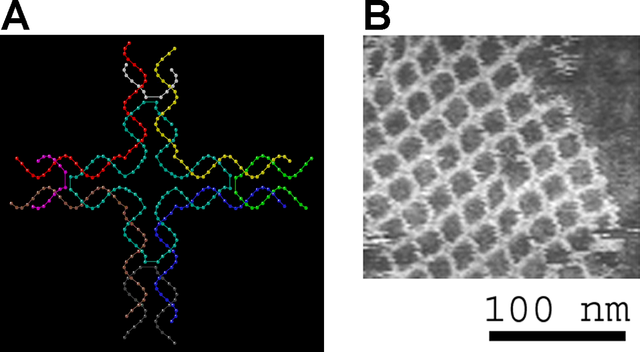 |
This is a file from the Wikimedia Commons. Information from its description page there is shown below.
Commons is a freely licensed media file repository. You can help.
|
 |
This is a nanotechnology selected image, and is periodically featured at the nanotechnology portal. To suggest changes to the list of selected content, see this talk page. |
| Description |
Self-Assembled DNA Nanostructures. (A) DNA “tile” structure consisting of four branched junctions oriented at 90° intervals. These tiles serve as the primary “building block” for the assembly of the DNA nanogrids shown in (B). Each tile consists of nine DNA oligonucleotides as shown. (B) An atomic force microscope image of a self-assembled DNA nanogrid. Individual DNA tiles self-assemble into a highly ordered periodic two-dimensional DNA nanogrid. |
| Date |
Published: March 16, 2004 |
| Source |
Strong M: Protein Nanomachines. PLoS Biol 2/3/2004: e73. http://dx.doi.org/10.1371/journal.pbio.0020073 |
| Author |
(Images were kindly provided by Thomas H. LaBean and Hao Yan.) |
Permission
( Reusing this file) |

 |
This file is licensed under the Creative Commons Attribution 2.5 Generic license. |
|
|
|
- You are free:
- to share – to copy, distribute and transmit the work
- to remix – to adapt the work
- Under the following conditions:
- attribution – You must attribute the work in the manner specified by the author or licensor (but not in any way that suggests that they endorse you or your use of the work).
http://creativecommons.org/licenses/by/2.5 CC-BY-2.5 Creative Commons Attribution 2.5 truetrue
|
|
This file was published in a Public Library of Science journal. Their website states that the content of all PLOS journals is published under the Creative Commons Attribution 2.5 license, unless indicated otherwise.
|
|
File usage
The following pages on Schools Wikipedia link to this image (list may be incomplete):
This selection has made Wikipedia available to all children. SOS Childrens Villages believes education is an important part of a child's life. That's why we ensure they receive nursery care as well as high-quality primary and secondary education. When they leave school, we support the children in our care as they progress to vocational training or higher education. Will you help another child today?



